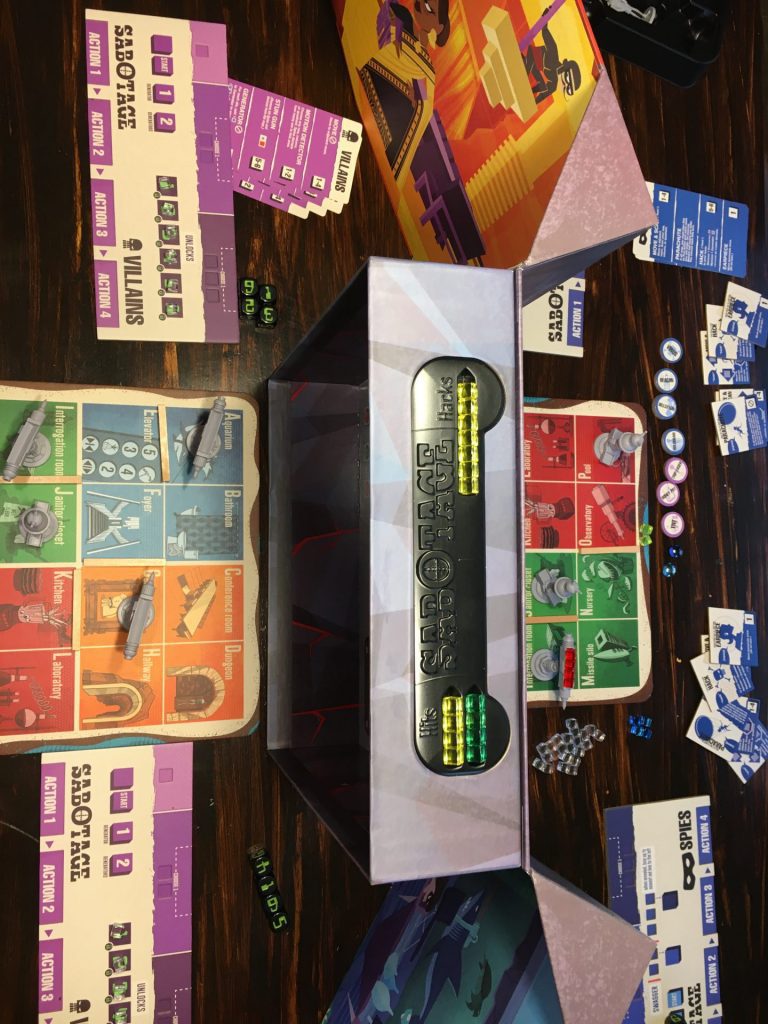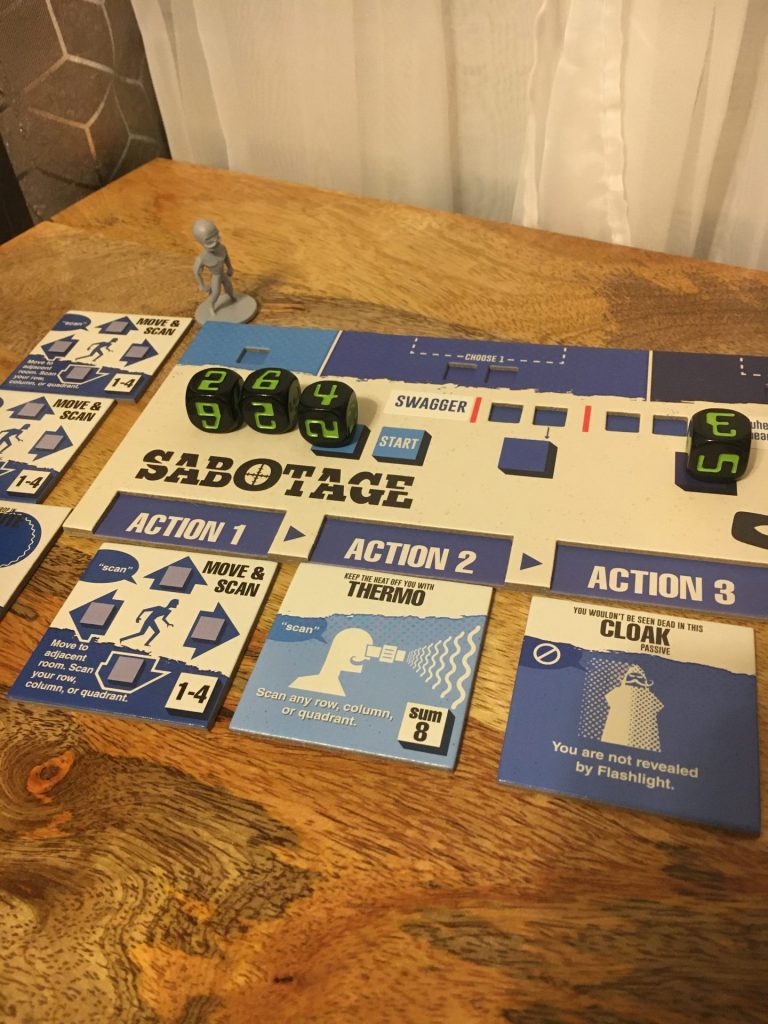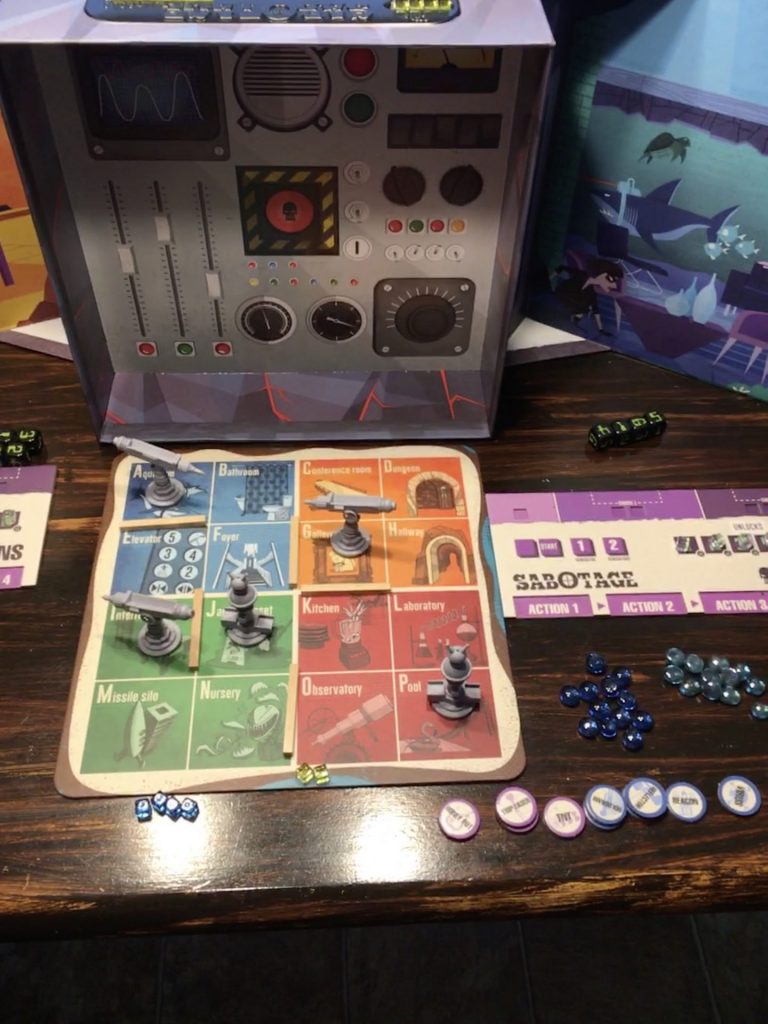Disclosure: Meeple Mountain received a free copy of this product in exchange for an honest, unbiased review. This review is not intended to be an endorsement.
Spy VS Bad Guy
The name of the game is Sabotage and you are in for a world of hidden movement and action programming heaven! In Sabotage two players or teams of two battle it out as spies and villains looking to save the world, or destroy it. The game takes place in the villain’s lair where the heroic spies are trying to deactivate the villain’s treacherous doomsday device before it can activate. The villains are seeking to, well, kill the spies. Don’t look so shocked, they are evil after all. So as the spies look to deactivate doomsday devices, the villains are just off looking to eliminate the home intruders about fit for an A-list action movie set in motion. Do you have what it takes to outthink and out-play the opposition to be victorious?
I like my Dice Shaken not Stirred

Sabotage is a hidden movement game played over a series of rounds with players controlling spies or villains. There will always be two spies and two villains in play no matter how many players are in the game. Teams will take turns programming and activating actions to move their respective units around the board and activate special abilities, traps and attacks. It is important to note that Sabotage is played with a screen blocking the opponent’s view of your board so all movement is hidden, though some actions may call for limited information to be disclosed. Let’s talk about how each phase of the game is played and then discuss my impressions from gameplay.
Each character comes with a set number of dice, a player board with standard and character-specific actions to program from round to round. To start each round of Sabotage, a villain player rolls their dice and declares the numbers they rolled on each. Then, each player sets their dice to match. In this way, all players begin each round with the same numbers on their dice faces, but how they utilize them can be entirely unique.
This begins the programming phase of the game. Players simultaneously begin using their dice to activate and then program the actions they will take in the next phase. Each player, villain or spy, has a number of actions their unit can take; each action requires a certain dieface or a sum of several dice to activate that action. Players spend their dice to lock in specific actions and then arrange those actions in the order they wish to trigger them in the next round.
After all players have planned their actions, we move to the action phase. Actions in Sabotage range from movement to motion sensors (to look for enemies) to attacks that injure another player. This is where the depth and flavor come into play as different characters function and feel very unique. Of course, it’s not just about what actions you have, it’s about how you use them that counts!

In the action phase, players go back and forth, starting with a villain, choosing one of their units and activating all of their chosen abilities in order. Next, a spy will take a turn, then the second villain, then the second spy. Here is where the strategic beauty of Sabotage comes into play. Players are challenged with important choices about who to activate first. Even if they have the right actions programmed, it is all pointless if their target has moved or if some new encumbrance has been added to their path. Choosing who goes first adds a new enjoyable layer to the programming aspect of Sabotage. During this phase spies and villains can level up and collect new, more powerful actions to use as well as additional dice needed for these actions. The requirements vary depending on the team; the spies are seeking not to be attacked or detected by the villains and the villains working to power up their generators found around the map. Successfully meeting these requirements will allow the team to up their dice pool, increasing their potential actions. These power-ups are also able to be mitigated by the spies which creates a great deal of tension as players plan out the optimal turns.
After all of the actions are concluded, players reset their boards and check for game end. If the spies have managed to hack the villains doomsday devices 8 times, they win the game! Conversely, if the Villains are able to “hit” the spies 5 times, they will be victorious in slowing the spies enough for their machines to activate!
Is this Diamond Forever?

Sabotage takes some bits and pieces of my favorite hidden movement games and blends them with what I love about Captain Sonar and the best programming titles on the market. The result is a glorious concoction of stealth and pre-planned shenanigans. As with any programming game, half of the best-laid plans are completely foiled by luck or miscalculations, which is compounded exponentially in Sabotage by the fact that you cannot even SEE your opponents. I felt as though I was playing Battleship from time to time as I worked to scan and search for my opponents or perhaps their traps around the board. The glorious outplays and deep satisfaction of successfully laid plans make this title a vibrant experience.
There are some points to note though, as with all games, Sabotage may not be for everyone. While I enjoy programming in limited doses, some players may be exasperated by their plans coming up short. I will also note that this game, since it is unique, requires players to be of similar skill levels as one experienced player could mop the floor with gamers unfamiliar with programming or hidden movement mechanisms. I also feel this game was designed for exactly 4 players, that is 2 teams of two. I did not enjoy playing at 2 nearly as much. This could be a personal thing as I like “role-playing” a character and needing to control both just seemed a bit much for me, but I believe the game shines most brightly at 4 with each player contributing and really adding to the chaos.
So Does Sabotage Have a License to Kill or is it Time for it to Die Another Day?

I believe Sabotage hits a niche and checks a lot of boxes for me as a keeper. I have not even commented yet on the amazing quality of the components, game trays, and the ingenious use of the entire box as a divider for the game. This coupled with Ryan Goldsberry’s amazing art and grounded mechanics make Sabotage an easy recommendation for someone looking for a hidden movement or programming game for their collection.
Sabotage
Genre: hidden movement/programming
Pros: beautiful components, engaging and unique gameplay
Cons: specific player count, programming is niche, experienced players have a leg up
Rating: 7.5/10 a really beautiful and engaging experience that I recommend.











Sounds cool and fun! I will have to see if I can try it somewhere.